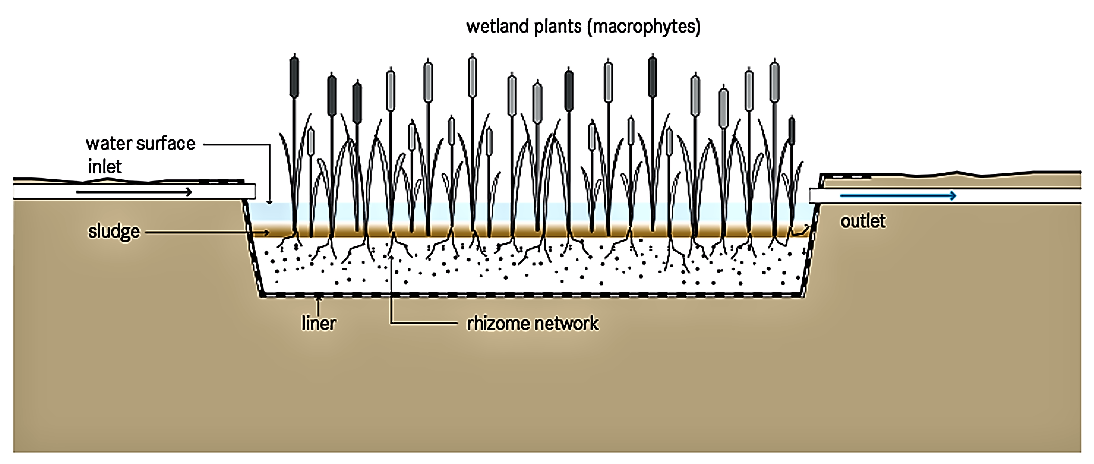Executive Summary
A free-water surface constructed wetland aims to replicate the naturally occurring processes of a natural wetland, marsh or swamp. As water slowly flows through the wetland, particles settle, pathogens are destroyed, and organisms and plants utilize the nutrients. This type of constructed wetland is commonly used as an advanced treatment after secondary or tertiary treatment processes.
| In | Out |
|---|---|
| Blackwater, Greywater, Brownwater |
Fertigation Water, Treated Water |
Introduction
Unlike the Horizontal Subsurface Flow Constructed Wetland, the free-water surface constructed wetland allows water to flow above ground exposed to the atmosphere and to direct sunlight. As the water slowly flows through the wetland, simultaneous physical, chemical and biological processes filter solids, degrade organics and remove nutrients from the wastewater.
Raw blackwater should be pre-treated to prevent the excess accumulation of solids and garbage. Once in the pond, the heavier sediment particles settle out, and this also removes the nutrients attached to them. Plants and the communities of microorganisms that they support (on the stems and roots), take up nutrients like nitrogen and phosphorus. Chemical reactions may cause other elements to precipitate out of the wastewater. Pathogens are removed from the water by natural decay, predation from higher organisms, sedimentation and UV irradiation.
Although the soil layer below the water is anaerobic, the plant roots exude (release) oxygen into the area immediately surrounding the root hairs, thus, creating an environment for complex biological and chemical activity.

Design considerations
The channel or basin is lined with an impermeable barrier (clay or geo-textile) covered with rocks, gravel and soil and planted with native vegetation (e.g., cattails, reeds and/or rushes). The wetland is flooded with wastewater to a depth of 10 to 45 cm above ground level. The wetland is compartmentalized into at least two independent flow paths. The number of compartments in series depends on the treatment target. The efficiency of the free-water surface constructed wetland also depends on how well the water is distributed at the inlet. Wastewater can be fed into the wetland, using weirs or by drilling holes in a distribution pipe, to allow it to enter at evenly spaced intervals.
Health aspects/acceptance
The open surface can act as a potential breeding ground for mosquitoes. However, good design and maintenance can prevent this.
Free-water surface constructed wetlands are generally aesthetically pleasing, especially when they are integrated into pre-existing natural areas.
Care should be taken to prevent people from coming in contact with the effluent because of the potential for disease transmission and the risk of drowning in deep water.
Operation and maintenance
Regular maintenance should ensure that water is not short-circuiting, or backing up because of fallen branches, garbage, or beaver dams blocking the wetland outlet. Vegetation may have to be periodically cut back or thinned out.
Free-water surface constructed wetlands can achieve a high removal of suspended solids and moderate removal of pathogens, nutrients and other pollutants, such as heavy metals. This technology is able to tolerate variable water levels and nutrient loads. Plants limit the dissolved oxygen in the water from their shade and their buffering of the wind; therefore, this type of wetland is only appropriate for low-strength wastewater. This also makes it appropriate only when it follows some type of primary treatment to lower the BOD. Because of the potential for human exposure to pathogens, this technology is rarely used as secondary treatment. Typically, it is used for polishing effluent that has been through secondary treatment, or for stormwater retention and treatment.
The free-water surface wetland is a good option where land is cheap and available. Depending on the volume of the water and the corresponding area requirement of the wetland, it can be appropriate for small sections of urban areas, as well as for peri-urban and rural communities. This technology is best suited for warm climates, but can be designed to tolerate some freezing and periods of low biological activity.
Small and Decentralized Wastewater Management Systems
Decentralised wastewater management presents a comprehensive approach to the design of both conventional and innovative systems for the treatment and disposal of wastewater or the reuse of treaded effluent. Smaller treatment plants, which are the concern of most new engineers, are the primary focus of this book.
CRITES, R. TCHOBANOGLOUS, G. (1998): Small and Decentralized Wastewater Management Systems. New York: The McGraw-Hill Companies IncConstructed Wetlands for Pollution Control
Treatment Wetlands. 2nd Edition
This book supports in making informed decisions regarding wetland design.
KADLEC, R. H. WALLACE, S. D. (2009): Treatment Wetlands. 2nd Edition. Boca Raton: CRC Press, Taylor & Francis Group URL [Accessed: 09.06.2019]Guidelines for Using Free Water Surface Constructed Wetlands to Treat Municipal Sewage
Constructed Wetlands for Wastewater Treatment and Resource Recovery
Wastewater Treatment II
Manual – Constructed Wetlands Treatment of Municipal Wastewater
This manual discusses the capabilities of constructed wetlands, a functional design approach, and the management requirements to achieve the designed purpose. The manual also attempts to put the proper perspective on the appropriate use, design and performance of constructed wetlands. Furthermore, the document contains two case studies.
U.S. EPA (1999): Manual – Constructed Wetlands Treatment of Municipal Wastewater. Washington D.C.: United States: Environmental Protection Agency (EPA) URL [Accessed: 09.06.2019]Constructed Wetlands for Wastewater Treatment: A Review
Presentation of different types of constructed wetlands for various types of wastewater.
VYMAZAL, J. SENGUPTA, M. ; DALWANI, R. (2008): Constructed Wetlands for Wastewater Treatment: A Review. (= Proceedings of Taal 2007: The 12th World Lake Conference ). Czech Republic: ENKI, o.p.s. and Institute of Systems Biology and Ecology, Czech Academy of Sciences URL [Accessed: 09.06.2019]
